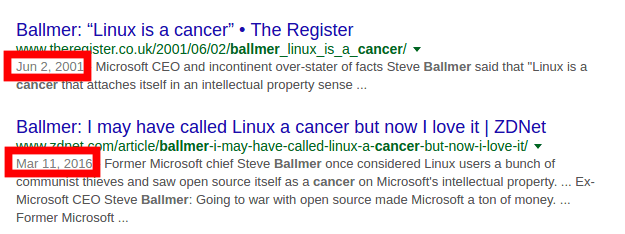If you are using any technology driven product, you are most likely to be using an open source software knowingly or unknowingly. Did you ever realize that the website you visit from your desktop or a smartphone browser is hosted on some cloud platform running Linux? Nearly 1 in 3 machines on Microsoft Azure is running Linux. The growing base of open source is acknowledged by the large corporations like Microsoft today and many of them including MS are becoming more open towards open source. See how things have changed in 15 years -

Corporations are not simply using open source but are even contributing back to open source projects. Not just Enterprises focused on building software, Open Source technology has also caught the attention of telecom companies worldwide. Last year, we wrote how Open Source Technology Powers People's Own Telecom Network. Today we explore how open source revolution is helping the telecom industry worldwide.
The Players
Beyond Operating Systems, billing, and NFV (Network Functions Virtualization) are the key areas where the telecom industry is adopting open source. By taking the open source route, telcos are able to save big in terms of licensing costs and also would be in a position to leverage capabilities offered by different hardware vendors instead of one single vendor. Coupled with the movement for Open Standards, proprietary vendor lock-in becomes avoidable. Software and hardware vendors are also warming up to open standards and are joining such consortiums to define acceptable standards. Many big brands who are known for proprietary software and hardware are the members of Linux Foundation. A notable project here is OPNFV
A carrier-grade, integrated, open source platform to accelerate the introduction of new NFV products and services. As an open source project, OPNFV is uniquely positioned to bring together the work of standards bodies, open source communities and commercial suppliers to deliver a de facto standard open source NFV platform for the industry.


Leading players in the NFV segment are OpenStack and Red Hat.

At the telcos end
AT&T
In the Open Networking Summit held in March 2016, AT&T's John Donovan, Chief Strategy Officer and Group President, Technology, and Operations stated
“We doubled our usage of open source software in just the last year, going from 5% to 10%, and that number continues to grow”
Earlier this month AT&T open sourced their network playbook which powers their SDN (software-defined network)
With the ability to quickly add features and drive down operation costs, ECOMP (Enhanced Control, Orchestration, Management, and Policy) gives service providers and businesses more control over their network services and enables developers to create new services. A network that better adapts, scales, and predicts how to make connected experiences seamless is a huge benefit for consumers.
Further, AT&T also has an active open source project on GitHub.
In India
Airtel
Back in June 2016, Airtel announced that they would be moving customer data to the Cloudera Platform. Cloudera built on leading open source framework Hadoop would enable Airtel to manage data better and derive insightful analytics. Big data analytics is the favorite subject of every consumer-facing brand today due to the immense benefits that can come out of it.
RCOM, MTS
A 2015 ET story reports that RCOM and MTS are using open-source software for their Business Support Systems (BSS) like billing & CRM, data, and voice value-added services, applications, tele-databases and virtualisation of the server system.
Conclusion
One of the prime reasons earlier for companies to move to proprietary framework was better support. But now with tight budgets, lower margins and improved support options for open source software, enterprises including telcos worldwide are more open to adopting open source. We, therefore, expect open source adoption to grow significantly in the telecom industry in the coming years.
Are you seeing increased adoption of open source software around you? Let us know via comments or tweet to me @gischethans.















